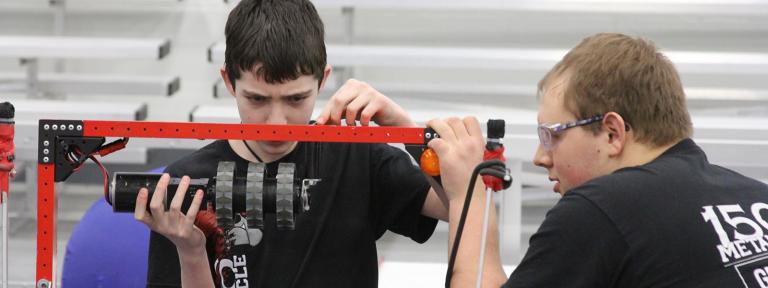
“The students on these teams will have a year-round home on our campus. More importantly, this will give more schools in the area the opportunity to start FIRST programs.”
Approximately 25 percent of Kettering University students participated in FIRST Robotics programs before attending Kettering. Kettering was one of the first university’s in the country to begin offering scholarships to FIRST students. The University sponsors the Metal Muscle team (winners of the prestigious 2014 Chairman’s Award), hosts many FIRST events on campus throughout each year and has a long, proud partnership with the FIRST organization.
In September, Kettering’s relationship with FIRST will grow even stronger when the University opens the FIRST Robotics Community Center -- the first of its kind on any college campus in the country.
The facility will provide work areas for eight FIRST teams, a regulation size practice field as well as a lab that includes machining tools and software. More importantly, the students on these teams will have unprecedented access to Kettering University’s faculty, staff and students as mentors and the campus facilities.
“This facility will allow Kettering to offer a truly immersive experience for the teams from the community who are housed here,” said Kettering University President Robert McMahan. “The students on these teams will have a year-round home on our campus. More importantly, this will give more schools in the area the opportunity to start FIRST programs.”
FIRST -- For Inspiration and Recognition of Science and Technology -- was founded by Dean Kamen in 1989 as a way for kids to sharpen skills and learn about career paths in science, technology and engineering fields. The competition-based program also fosters teamwork and communication skills and connects students with mentors working in industry and education. FIRST has a tremendous track record for preparing its participants for outstanding academic and professional careers.
Kettering has sponsored the Metal Muscle team for 10 years. Metal Muscle -- which will be one of the eight teams housed in the FIRST Community Center -- is unique in that it is not associated with a high school. It is composed of students from a wide variety of backgrounds and schools, including home schooled and private school students and students from underserved or small districts in the Flint area and in Oakland County.
Metal Muscle’s presence on campus also allows Kettering to work with students on a variety of academic endeavors, including ACT preparation. All participants are given the ACT when joining the team. From their scores, mentors are able to determine subject areas where the students need improvement and they receive tutoring as part of their participation in the program.
“Metal Muscle has been incredibly successful,” McMahan said. “Nearly 100 percent of students who have been on the team -- many of whom joined with no college aspirations -- have gone on to pursue a college education after high school. Having them on our campus, working with Kettering faculty and students, and getting exposure to the career possibilities a college education offers is life-changing for many of these students. The FIRST Community Center will allow us to offer these opportunities to significantly more students each year.”
The FIRST Community Center will be housed in what was formerly a gymnasium in the Academic Building. The gym, which is approximately 10,000 square feet, had been closed and used for storage since 1995. Dr. Henry Kowalski, Kettering University professor of Mechanical Engineering and the faculty mentor for the Metal Muscle team who is celebrating his 50th year at Kettering, has long eyed the gym as an opportunity to offer a space for FIRST Robotics.
“This is going to be a great use of the old gym’s space,” Kowalski said. “These kids need access to a modern machine shop, design space and a practice field, and this will give them a chance to have a simulated field that really prepares them for their competitions.”
In addition to the machining and design areas and practice field, teams will have eight ‘bays’ or ‘cages’ to store their own equipment and work with their teammates. There will also be spaces for teams to work together, supporting the collaborative nature of FIRST competitions that often see teams working in alliances with opponents. The space will also allow Kettering the opportunity to eventually get more involved in the FIRST LEGO League, which is for elementary school students. Currently, Dr. Pete Gheresus, professor of Industrial Engineering, works with teachers in the community to start and implement their own LEGO League programs.
The space will be infused with technology so that teams can use and plug in devices. A mezzanine observation area is also planned.
The facility was made possible as part of a $15.5 million commitment the C.S. Mott Foundation made to Kettering in 2012. It will not only allow Kettering to offer a new, vibrant space that benefits the community, it will also prepare students with in-demand STEM (Science, Technology, Engineering and Mathematics) skills that will prepare them for both continuing education and the workforce.
“It’s much more than just the space that is important,” McMahan said. “The key to FIRST is mentors. This facility will give area students unprecedented access to our campus and all it has to offer as well as our faculty, staff and students. It will serve as a tremendous opportunity to partner with the community and help prepare the next generations of students for college and impactful careers.”